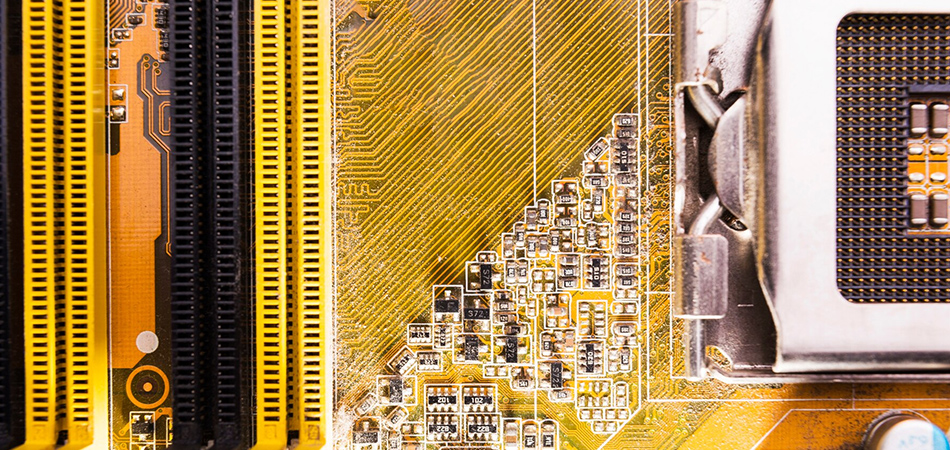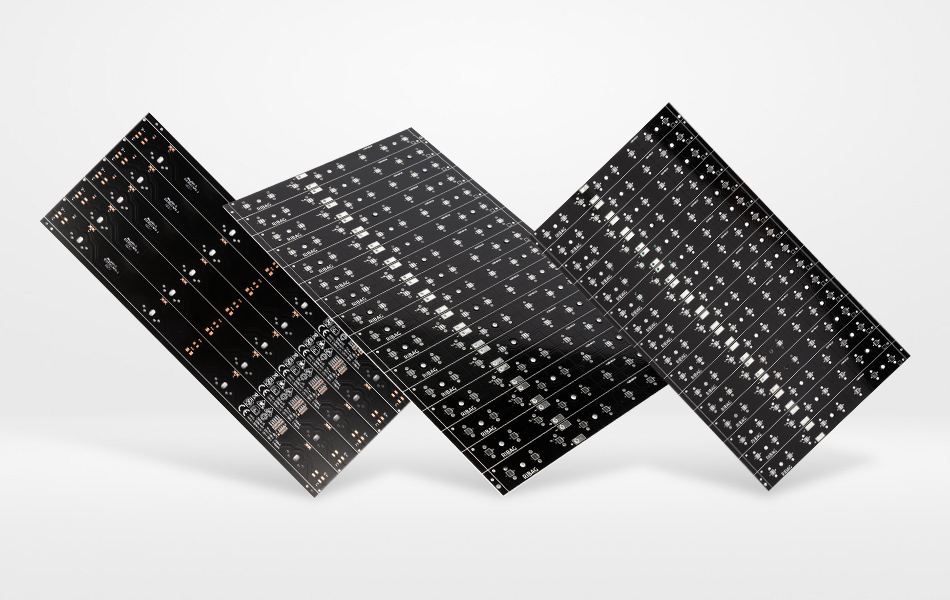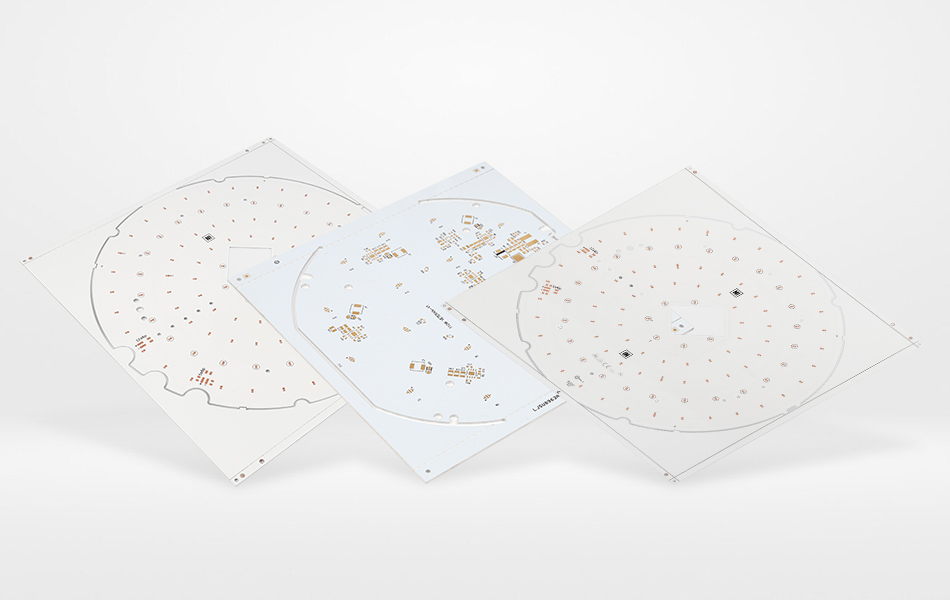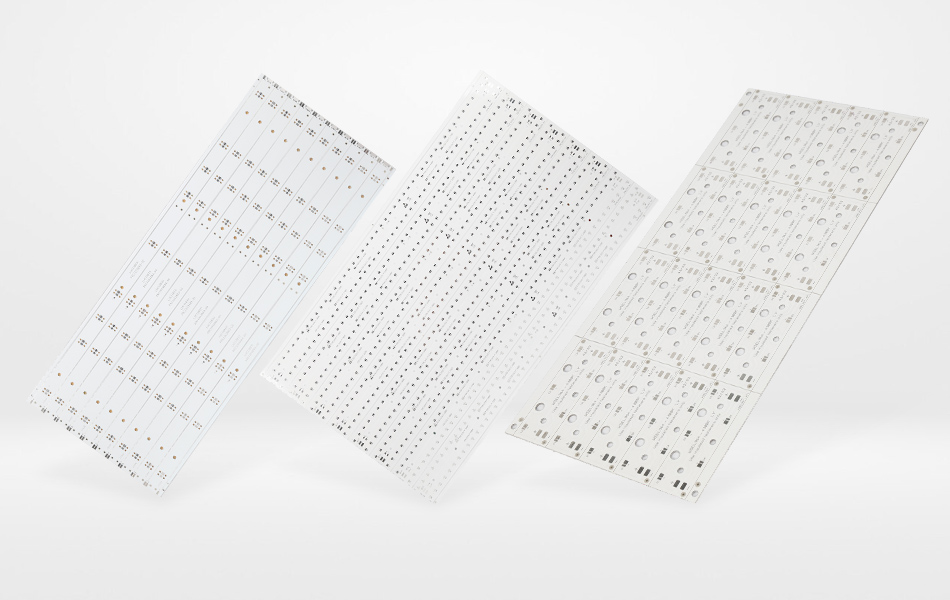-
- PCB TYPE
- PRINTED CIRCUIT BOARD PROTOTYPE ALUMINUM PRINTED CIRCUIT BOARD R&F PCB FPC HIGH FREQUENCY PCB HIGH-TG PCB HEAVY COPPER PCB HDI PCB PCB FOR LIGHTING METAL CORE PCB
time:Jun 25. 2025, 09:45:03
In the dynamic realm of modern lighting technology, Surface - Mount Device (SMD) LEDs have revolutionized the industry with their compact size, energy - efficiency, and high - performance illumination. Complementing these cutting - edge LEDs is the aluminum printed circuit board (PCB), a critical component that significantly enhances the functionality and reliability of SMD LED lighting systems. SMD LED aluminum lighting PCBs combine the advantages of SMD LEDs' precise light emission and the superior thermal and mechanical properties of aluminum PCBs, making them indispensable across a wide spectrum of lighting applications.
The synergy between SMD LEDs and aluminum PCBs addresses key challenges in lighting design, such as effective heat management, space optimization, and long - term durability. As the demand for sustainable, high - quality lighting solutions continues to grow in various sectors, understanding the intricacies of SMD LED aluminum lighting PCBs becomes crucial for lighting engineers, manufacturers, and industry professionals. This article comprehensively explores their structure, benefits, design considerations, manufacturing processes, applications, and market dynamics, shedding light on their role in shaping the future of the lighting industry.
Structure of SMD LED Aluminum Lighting PCBs
Layered Composition
SMD LED aluminum lighting PCBs feature a multi - layer architecture, with each layer playing a distinct and vital role. At the core lies the aluminum substrate, renowned for its high thermal conductivity. This substrate acts as a robust foundation, not only providing mechanical support but also serving as an efficient heat sink to dissipate the heat generated by SMD LEDs during operation. By rapidly transferring heat away from the LEDs, the aluminum substrate ensures they operate within optimal temperature ranges, preventing performance degradation and extending their lifespan.
Above the aluminum substrate is the dielectric layer, which functions as an electrical insulator, separating the conductive copper traces from the aluminum base. The dielectric material is carefully selected to possess high dielectric strength, excellent thermal stability, and low thermal resistance. Advanced polymers, often reinforced with thermally conductive fillers, are commonly used for this layer. These materials create a balance between effective electrical insulation and efficient heat transfer, safeguarding the integrity of the electrical circuits while facilitating the movement of heat towards the aluminum substrate.
The outermost layer consists of the copper traces, which are precisely patterned to form the electrical circuits that power and control the SMD LEDs. High - purity copper is utilized for its superior electrical conductivity, ensuring seamless transmission of electrical signals. The design of the copper traces, including their width, spacing, and routing, is optimized to meet the specific electrical requirements of the SMD LEDs, ensuring stable power supply and reliable operation.
Material Selection
Aluminum Substrate
The choice of aluminum alloy for the substrate is a critical decision. Different alloys offer varying combinations of thermal conductivity, mechanical strength, and corrosion resistance. For SMD LED lighting applications, alloys with enhanced thermal conductivity are highly preferred. These alloys can quickly absorb and disperse the heat produced by SMD LEDs, maintaining a stable operating temperature. Additionally, factors such as the application environment, mechanical stress levels, and desired lifespan influence the selection of the aluminum alloy. In outdoor lighting applications, for example, an aluminum alloy with excellent corrosion resistance is often chosen to withstand harsh weather conditions.
Dielectric Layer
The dielectric layer material must strike a delicate balance between electrical and thermal properties. Polyimide - based dielectrics are popular due to their high thermal stability, allowing them to endure the elevated temperatures generated by SMD LEDs. They also provide reliable electrical insulation, preventing electrical short - circuits. To further enhance the thermal conductivity of the dielectric layer, ceramic fillers like aluminum oxide or boron nitride are frequently added. These fillers create a network within the dielectric matrix, facilitating more efficient heat transfer from the copper traces to the aluminum substrate.
Copper Traces
High - purity copper is the material of choice for the copper traces to maximize electrical conductivity. The thickness of the copper layer is determined based on the current - carrying capacity requirements of the SMD LEDs. Thicker copper layers can handle higher currents but increase the cost and weight of the PCB. The surface finish of the copper traces is also important, with options such as electroless nickel immersion gold (ENIG), organic solderability preservative (OSP), and hot - air solder leveling (HASL) offering different advantages in terms of solderability, corrosion resistance, and electrical performance. The selection of the surface finish depends on the specific application requirements and manufacturing processes.

Advantages of SMD LED Aluminum Lighting PCBs
Exceptional Heat Dissipation
One of the most significant advantages of SMD LED aluminum lighting PCBs is their outstanding heat - dissipation capabilities. SMD LEDs, despite their energy - efficiency, generate a considerable amount of heat during operation. Excessive heat can lead to a decrease in light output, color shift, and a shortened lifespan. The aluminum substrate in these PCBs acts as an efficient heat - dissipation medium, rapidly absorbing and spreading the heat across its surface. This efficient heat management ensures that SMD LEDs operate at lower and more stable temperatures, maintaining consistent light quality and extending their service life.
In high - power SMD LED lighting fixtures, such as industrial floodlights or large - scale architectural lighting installations, effective heat dissipation is crucial. SMD LED aluminum lighting PCBs eliminate the need for complex and bulky cooling systems, reducing the overall size, weight, and cost of the lighting fixtures while ensuring reliable performance.
Compact and Space - Efficient Design
The combination of SMD LEDs and aluminum PCBs enables a highly compact and space - efficient lighting design. SMD LEDs are significantly smaller than traditional LED packages, allowing for a higher density of LEDs to be mounted on the PCB. The flat, surface - mount nature of SMD LEDs also simplifies the assembly process, reducing the overall height of the lighting module.
Aluminum PCBs, with their thin and lightweight structure, further contribute to the compact design. Their flexibility in design allows for intricate circuit layouts, enabling the integration of multiple SMD LEDs, drivers, and other components on a single board. This compact and space - efficient design is highly beneficial in applications where space is at a premium, such as in recessed lighting, under - cabinet lighting, and portable lighting devices.
Mechanical Robustness
SMD LED aluminum lighting PCBs offer excellent mechanical strength and durability. The aluminum substrate provides a rigid and stable base, protecting the delicate SMD LEDs and electrical components from mechanical stress, vibration, and shock. This mechanical robustness makes them suitable for a wide range of applications, including outdoor lighting, transportation lighting, and industrial lighting, where the lighting fixtures may be exposed to harsh environmental conditions.
The multi - layer construction of the PCB, with the layers bonded together under high - temperature and high - pressure conditions, creates a strong and cohesive structure. This enhances the overall mechanical integrity of the PCB, reducing the risk of damage during handling, installation, and operation.
Energy Efficiency and Longevity
By effectively managing the heat generated by SMD LEDs, aluminum PCBs contribute to the energy efficiency of the lighting system. When SMD LEDs operate at lower temperatures, they consume less power to produce the same amount of light, resulting in reduced energy consumption. This energy efficiency not only helps to lower electricity bills but also aligns with the growing demand for sustainable lighting solutions.
Moreover, the improved heat management and stable operating conditions provided by SMD LED aluminum lighting PCBs significantly extend the lifespan of SMD LEDs. Reduced heat stress minimizes the degradation of LED components, reducing the frequency of replacements and maintenance. This longevity makes SMD LED aluminum lighting PCBs a cost - effective solution in the long run, especially for large - scale lighting projects.

Design Considerations for SMD LED Aluminum Lighting PCBs
Thermal Design
SMD LED Placement
Proper placement of SMD LEDs on the aluminum PCB is essential for effective heat dissipation. SMD LEDs should be positioned to maximize their contact with the aluminum substrate. Placing them directly over thermal vias or in areas with good thermal conductivity helps to transfer heat away from the LEDs more efficiently. Additionally, the layout of SMD LEDs should be planned to ensure even heat distribution across the board. Avoiding clustering of high - power SMD LEDs in a single area prevents the formation of hotspots, ensuring consistent performance of all LEDs.
Thermal simulation tools can be used to analyze the heat flow and temperature distribution on the PCB, helping designers optimize the SMD LED placement for optimal heat dissipation. These tools provide valuable insights into the thermal behavior of the PCB under different operating conditions, allowing for informed design decisions.
Thermal Via Design
Thermal vias play a crucial role in facilitating heat transfer from the SMD LEDs to the aluminum substrate. The design of thermal vias, including their size, number, and distribution, needs to be carefully optimized. Larger thermal vias can transfer more heat but may take up more space on the PCB, affecting the circuit layout. The number of thermal vias should be sufficient to handle the heat generated by the SMD LEDs, and their distribution should be based on the heat - generation patterns of the LEDs.
Advanced manufacturing techniques, such as blind and buried vias, can be used to optimize the thermal via design. These techniques allow for more efficient heat transfer while minimizing the impact on the PCB's surface area and electrical performance.
Heat - Sink Integration
In some high - power SMD LED lighting applications, integrating a heat sink with the aluminum PCB can further enhance heat dissipation. The heat sink provides additional surface area for heat transfer to the surrounding environment. When integrating a heat sink, ensuring good thermal contact between the heat sink and the aluminum substrate is crucial. Thermal interface materials, such as thermal paste or pads, are used to fill the gaps between the two surfaces, improving heat transfer efficiency.
The design of the heat sink, including its size, shape, and fin configuration, should be tailored to the specific heat - dissipation requirements of the SMD LED lighting system. A well - designed heat - sink integration can significantly improve the performance and lifespan of the SMD LEDs, while also considering factors such as cost, size, and aesthetics.
Electrical Design
Trace Routing
Trace routing in SMD LED aluminum lighting PCBs requires careful planning to ensure reliable electrical performance. The copper traces should be routed to minimize resistance, inductance, and capacitance, especially for high - current applications. Short and wide traces are preferred to reduce resistance and power losses. Sharp corners and bends in the traces should be avoided as they can increase inductance and cause signal integrity issues.
In addition, proper separation of power and signal traces is essential to prevent electromagnetic interference (EMI). Shielding techniques can be employed for sensitive signal traces to further enhance signal integrity. The routing of traces should also take into account the placement of SMD LEDs and other components to ensure a compact and efficient circuit layout.
Power and Ground Plane Design
A well - designed power and ground plane is crucial for stable power distribution and reduced EMI in SMD LED aluminum lighting PCBs. The power plane should provide a low - impedance path for the power supply to the SMD LEDs, ensuring a stable and consistent voltage. The ground plane serves as a reference for the electrical circuits and helps to reduce EMI by providing a return path for the current.
To minimize voltage drops and improve power distribution, the power and ground planes should be as large as possible. Decoupling capacitors should be strategically placed near the SMD LEDs and other components to filter out high - frequency noise and stabilize the power supply. Proper grounding techniques, such as star grounding or single - point grounding, can also be implemented to reduce EMI and improve the overall electrical performance of the PCB.
Design for Manufacturability
Designing SMD LED aluminum lighting PCBs with manufacturability in mind is essential for cost - effective production. Using standard SMD LED packages and component footprints simplifies the procurement process and reduces the risk of errors during assembly. Avoiding complex shapes and geometries in the PCB design makes the manufacturing process more straightforward, reducing production time and costs.
The design should also be compatible with the selected manufacturing processes, such as surface - mount technology (SMT) assembly, soldering, and testing. Clear design guidelines and specifications should be provided to the manufacturing team to ensure consistent and high - quality production. Consideration of factors such as solderability, component placement accuracy, and testability during the design phase can significantly improve the overall manufacturing efficiency.

Manufacturing Processes of SMD LED Aluminum Lighting PCBs
Material Preparation
The manufacturing process of SMD LED aluminum lighting PCBs begins with the careful selection and preparation of materials. High - quality aluminum sheets with the appropriate alloy composition are chosen based on the thermal and mechanical requirements of the PCB. These sheets are cut to the desired size and shape for the substrate.
The dielectric material, usually in the form of a pre - impregnated film or a liquid resin, is prepared. Pre - impregnated films are made by impregnating a base material, such as fiberglass, with a thermosetting resin and are cured to a semi - cured state for easy handling and lamination. Liquid resins are mixed with fillers and additives to achieve the desired electrical and thermal properties. High - purity copper foils are selected for the traces and undergo surface treatment to improve adhesion to the dielectric layer.
Lamination
Lamination is the process of bonding the aluminum substrate, dielectric layer, and copper foils together to form a single, cohesive structure. This is typically accomplished using heat and pressure in a laminator. The heat activates the thermosetting resin in the dielectric layer, causing it to flow and bond with the aluminum substrate and copper foils. The pressure ensures that the layers are in close contact, eliminating air gaps and voids.
Precise control of the lamination temperature, pressure, and time is crucial to achieve a high - quality bond. Different lamination techniques, such as vacuum lamination or press lamination, may be used depending on the specific requirements of the PCB. After lamination, the PCB is cooled and trimmed to the final dimensions.
Drilling and Plating
Following lamination, holes are drilled for vias, component mounting, and electrical connections. High - precision drilling machines are used to ensure accurate hole placement and clean hole walls. The drilled holes are then electroplated with copper to create electrical connections between the layers of the PCB.
Electroplating involves immersing the PCB in an electrolyte solution containing copper ions and applying an electric current. The copper ions are deposited on the surface of the holes and the copper traces, forming a continuous layer of copper. The thickness of the copper plating is carefully controlled to ensure proper electrical conductivity and mechanical strength.
Circuit Patterning
Circuit patterning is the process of creating the electrical circuits on the copper layers of the PCB. Photolithography is commonly used for this purpose. A photosensitive resist is applied to the copper surface, which is then exposed to ultraviolet (UV) light through a patterned mask. The areas of the resist exposed to UV light undergo a chemical change, making them soluble in a developer solution.
After development, the exposed copper areas are etched away using an etching solution, leaving behind the desired copper traces. This process requires high precision to ensure accurate trace widths, clearances, and the absence of shorts or open circuits. Advanced photolithography techniques and equipment are used to achieve the required level of precision in circuit patterning.
Surface - Mount Assembly
The surface - mount assembly process involves placing the SMD LEDs and other components onto the PCB. Automated pick - and - place machines are used to precisely position the components on the designated pads on the PCB. The components are then soldered to the PCB using reflow soldering or wave soldering techniques.
Reflow soldering is commonly used for SMD LED assembly. In this process, the PCB with the placed components is passed through a reflow oven, where the solder paste melts and bonds the components to the PCB. Proper control of the temperature profile in the reflow oven is essential to ensure good solder joints and reliable electrical connections.
Testing and Quality Control
After assembly, the SMD LED aluminum lighting PCBs undergo a series of tests to ensure their functionality and quality. Electrical tests, such as continuity testing, voltage and current testing, and insulation resistance testing, are performed to verify the integrity of the electrical circuits. Optical tests are conducted to measure the light output, color temperature, and color rendering index of the SMD LEDs.
Visual inspection is also carried out to check for any physical defects, such as solder bridges, missing components, or damaged traces. Automated optical inspection (AOI) and X - ray inspection can be used for more detailed and accurate quality control. Any defective PCBs are identified and either repaired or discarded to ensure that only high - quality products are delivered to customers.

Applications of SMD LED Aluminum Lighting PCBs
Architectural Lighting
SMD LED aluminum lighting PCBs are widely used in architectural lighting to create stunning lighting effects and enhance the aesthetic appeal of buildings. They can be used for general illumination, accent lighting, and decorative lighting. In building facades, SMD LED aluminum lighting PCBs enable the creation of dynamic lighting displays, highlighting architectural features and adding a unique visual element to the building.
In interior spaces, such as lobbies, galleries, and hotels, these PCBs are used to provide ambient lighting, create focal points, and set the mood. The ability to control the color, intensity, and direction of the light, combined with the compact and flexible design of SMD LED aluminum lighting PCBs, allows for endless design possibilities in architectural lighting.
Commercial Lighting
In commercial settings, such as retail stores, offices, and warehouses, SMD LED aluminum lighting PCBs offer energy - efficient and high - performance lighting solutions. In retail stores, they can be used for display lighting, shelf lighting, and general illumination, highlighting products and creating an inviting shopping environment.
In offices, SMD LED aluminum lighting PCBs provide comfortable and productive lighting, reducing eye strain and improving the overall work environment. Their long lifespan and low maintenance requirements make them a cost - effective choice for commercial lighting applications, reducing the frequency of bulb replacements and maintenance costs.
Outdoor Lighting
Outdoor lighting applications, such as streetlights, landscape lighting, and parking lot lighting, benefit greatly from SMD LED aluminum lighting PCBs. Their excellent heat - dissipation capabilities and mechanical robustness make them suitable for withstanding harsh outdoor conditions, including extreme temperatures, rain, and dust.
SMD LED aluminum lighting PCBs enable the design of energy - efficient outdoor lighting fixtures that provide bright and uniform illumination.


Got project ready to assembly? Contact us: info@apollopcb.com



We're not around but we still want to hear from you! Leave us a note:

Leave Message to APOLLOPCB
